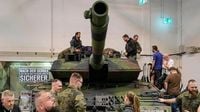In the heart of Europe, a seismic shift is underway. The United Kingdom, France, and Germany are spearheading an unprecedented wave of defense spending and military modernization, reshaping not only their own national security strategies but the entire European geopolitical landscape. As global tensions simmer and the specter of conflict in Ukraine persists, these nations are investing billions in advanced technologies, new weapons systems, and cross-border military ventures—moves that carry profound implications for investors, policymakers, and citizens alike.
According to reporting from AInvest and the World Socialist Web Site, the United Kingdom and France have taken center stage in what some analysts are calling a “new defense paradigm.” The UK’s 2025 Strategic Defence Review (SDR) outlines a bold commitment: defense spending will rise to 2.5% of GDP by 2027, with ambitions to reach 3% in the following Parliament. This is no small feat, especially after decades of post-Cold War austerity that saw military budgets pared to the bone. Meanwhile, France has accelerated its own defense budget to €64 billion ($74.8 billion) by 2027—three years ahead of its original schedule—demonstrating a sense of urgency not seen in decades.
But what’s driving this surge? The answer, in part, lies in a synchronized pivot toward technological superiority and strategic autonomy. Both the UK and France are pouring resources into artificial intelligence, cyber warfare, and autonomous systems, betting that tomorrow’s conflicts will be won not just with tanks and jets, but with data, algorithms, and unmanned platforms. The UK’s £11 billion annual defense industrial strategy and France’s €413 billion military programming law (spanning 2024–2030) are fueling transformative projects, from the UK’s “New Hybrid Navy” to France’s ambitious Future Combat Air System (FCAS), a joint venture with Germany and Spain.
These initiatives aren’t just about military readiness; they’re about building robust industrial ecosystems capable of exporting expertise and technology on a global scale. As AInvest notes, “the UK and France are not acting in isolation.” Their efforts are catalyzing a broader European rearmament trend, with Germany, Poland, and other countries ramping up their own defense budgets. This collective push is strengthening the so-called “European pillar” within NATO, accelerating joint projects and, crucially, providing coordinated support for Ukraine.
Germany’s role in this continental transformation cannot be overstated. As of early August 2025, the German federal government announced the delivery of two additional Patriot air defense systems to Ukraine—bringing its total to five batteries and making Germany the largest supplier of Patriot systems to the embattled nation. “Germany is by far the strongest supporter of Ukraine in the field of air defence,” declared Defence Minister Boris Pistorius, according to the World Socialist Web Site. Since 2022, Berlin has provided military support to Ukraine worth around €28 billion, including weapons, ammunition, heavy equipment, training, and direct industrial contracts.
But Germany’s ambitions extend well beyond Ukraine. The country is in the midst of its largest rearmament since the Nazi era, fueled by a €100 billion “special fund” for the Bundeswehr and a long-term military spending plan totaling around €1 trillion. The government is planning a procurement wave worth tens of billions of euros: 20 Eurofighter combat aircraft (€4–5 billion), up to 3,000 Boxer armored vehicles (€10 billion), up to 3,500 Patria infantry fighting vehicles (€7 billion), and—perhaps most strikingly—about 1,000 additional Leopard battle tanks over the next decade, a historic multiplication of German tank forces.
Other major contracts include 1,400 military logistics vehicles from Rheinmetall for €770 million, a framework agreement for up to 6,500 lorries worth €3.5 billion, 35 nuclear-capable F-35 fighter jets (€10 billion), 60 Chinook transport helicopters (€7 billion), and the Israeli Arrow 3 missile defense system (€4 billion). Rheinmetall alone has received €12 billion in Bundeswehr contracts for digitalization since the end of 2024, while Thyssenkrupp Marine Systems is seeing surging orders for submarines, frigates, and unmanned mine countermeasure systems.
For investors, this defense renaissance is creating a fertile landscape. In the UK, companies like BAE Systems, Rolls-Royce, and Leonardo UK are securing contracts for next-generation combat systems, propulsion technologies, and cyber capabilities. France’s Dassault Aviation, Naval Group, and Thales Group are similarly poised to benefit from the FCAS project, submarine production, and AI-driven battlefield systems. Joint ventures such as MBDA, a collaboration between Airbus, BAE Systems, and Leonardo, are leading Europe’s missile technology race, while Safran and Raytheon UK are capitalizing on the growing demand for advanced propulsion and sensor systems.
On the financial side, European sovereign bonds from the UK and France are being touted as stable investment options amid increased defense spending. Both nations are managing fiscal risks through industrial growth and strategic partnerships, with the UK’s “defence dividend” aiming to create jobs and boost private-sector collaboration. France’s strategy of linking defense spending to “economic activity and production” is designed to fuel GDP growth rather than balloon public debt. Credit rating agencies remain cautiously optimistic: the UK’s debt-to-GDP ratio stands at a stable 97%, while France’s is at 113%—both considered manageable, especially as neither nation is resorting to austerity measures that could stifle economic recovery.
Yet, this rearmament is not without controversy. Critics, particularly those on the left, warn of historical parallels to the militarization of Europe before World War II. The World Socialist Web Site draws a stark comparison, noting that “the same corporations that armed Hitler’s Wehrmacht in the 1930s are once again rubbing their bloody hands together and raking in billions.” The nuclear component of Germany’s buildup is especially contentious: the F-35 jets stationed at Büchel Air Base will be capable of delivering US nuclear bombs, raising fears of escalation in the event of direct conflict with Russia. Calls for an independent or Europeanized nuclear force are growing louder, reflecting both anxiety over US reliability and a desire for greater strategic autonomy.
The broader European context is one of collective action—and collective risk. Germany, the UK, France, and others are not only bolstering their own defenses but also deepening cooperation through NATO and joint ventures. Support for Ukraine, cross-border defense projects, and the strengthening of NATO’s European pillar all point to a new era of strategic alignment. For investors, this means opportunities in defense tech, aerospace, and sovereign credit—if they can navigate the complexities and ethical dilemmas of a rapidly evolving security environment.
As Europe redefines its role in a multipolar world, the intersection of national security, technological innovation, and economic resilience is shaping both the continent’s future and the fortunes of those who invest in it. The stakes, as history has shown, could not be higher.

